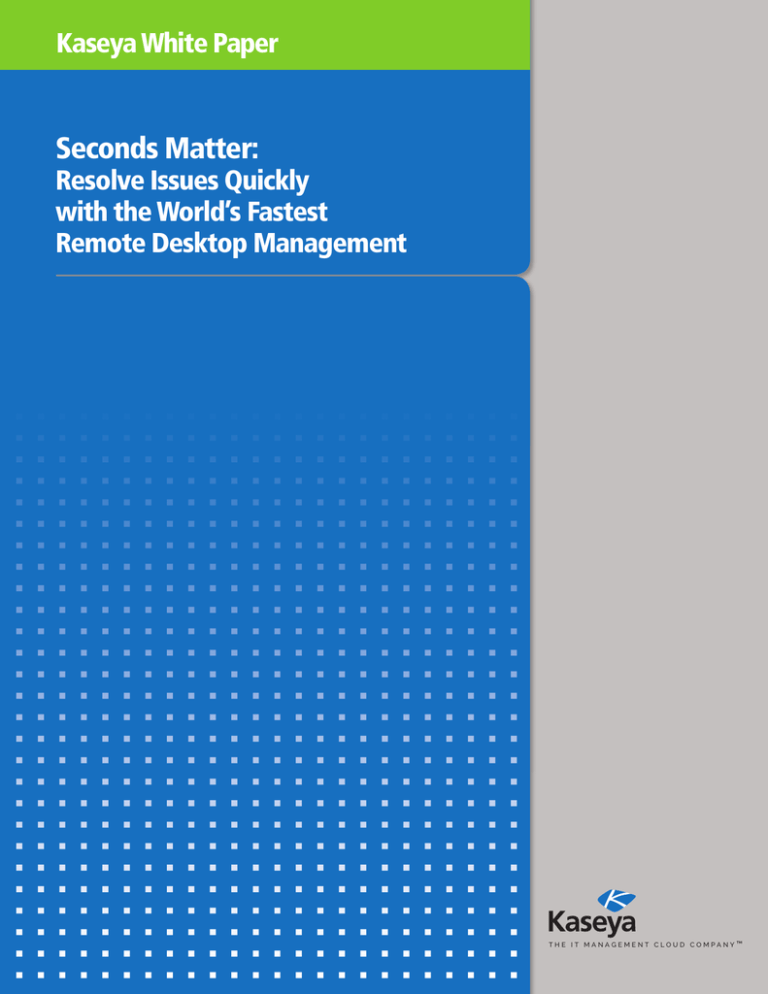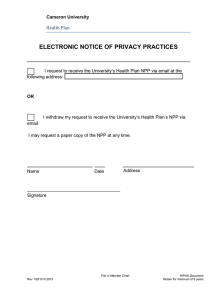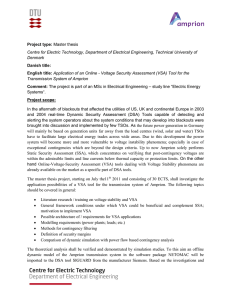
Kaseya White Paper
Seconds Matter:
Resolve Issues Quickly
with the World’s Fastest
Remote Desktop Management
THE IT MANAGEMENT CLOUD COMPANY™
Kaseya White Paper | World’s Fastest Remote Desktop Management
As an IT professional, you know that when you have many users to support,
every second counts! Slow remote desktop connection times and poor, unreliable
connection performance can add up to significant time wasted when extended
over days, weeks and months of remote control sessions. When a remote control
session is required, you need to know that your connection can be established
rapidly and reliably with just the click of a button. Your remote connection speed
and reliability are critical to your ability to resolve issues quickly, maximizing IT
efficiency and ensuring a happy and productive end user.
The Kaseya Solution
Kaseya Virtual System Administrator (VSA) delivers the fastest, most reliable remote management
solution in the industry. IT professionals can access and manage computers from anywhere at near
instantaneous connect times with extraordinary reliability, even over high latency networks. The VSA
web-based, integrated IT management platform delivers a complete, fast and secure live remote
control solution, even behind firewalls or when connecting from machines at home.
Kaseya VSA includes two modes of operation:
Remote Control enables the technician to take over the remote computer collaboratively with
the end user. They can work collaboratively or the technician can work with full computing access as
the currently logged in user. All operations are as if the technician were physically sitting in front of
the computer.
Live Connect enables the technician to work behind the scenes without the end user’s
knowledge. The technician is able to fix problems in the registry, move or copy files, run a command
prompt or script, view running tasks, and more. Meanwhile the end user is able to continue
uninterrupted.
The Kaseya Virtual System Administrator
(VSA) Remote Control module enables near
instantaneous remote desktop management
connections.
Kaseya White Paper | World’s Fastest Remote Desktop Management
The Kaseya Technology
To achieve the fastest and most reliable remote management solution requires innovative new
methods and technology.
Ready-to-Connect Agent: When first connecting the management server to a new agent,
downloading remote desktop management binaries to the agent represents a substantial portion of
the connect time. With VSA Remote Control, this delay is completely eliminated. Everything needed
for Remote Control is included when the agent is initially installed, and is always available for
immediate use.
Agent to Server Persistence: Likewise, the time to schedule and run an agent procedure
against an agent has traditionally accounted for a large portion of the time to connect. Rather than
attempt to optimize this, VSA Remote Control doesn’t run an agent procedure at all. The VSA Server
and Agent establish a persistent, lightweight, always-on connection between server and agent,
which is available to start Remote Control immediately. Because of this persistent connection,
commands can be sent, received and responded to in milliseconds. IT professionals can initiate a
remote access request and receive a response from the agent in near real-time. This increases the
time-to-connect speed substantially.
Parallel Set-up: Establishing a Remote Control session can involve a surprising number of
individual steps. For example:
■
■
■
■
■
■
■
■
■
■
Launch the viewer application
Establish a connection from the viewer to the VSA server
Perform encryption handshakes to ensure each connection is secure
Send Remote Control session details to the agent
Wait for the user to accept the Remote Control session (if required by policy)
Establish relayed connectivity
Collect network candidates for P2P connectivity
Transmit P2P connection candidates over the network
Perform P2P connectivity tests
Select the best available network connection to start the session on
Most remote management technology communicates in a very sequential manner, meaning there
is a “wait in line” restriction that slows down on-demand requests. With the VSA communication
layer, remote control requests don’t get queued behind other activities on the agent. In addition, all
activities required to set up a remote control session are performed in parallel. For example, if end
user permission is required to start a session, connectivity will be established behind the scenes in
the meantime, so it’s ready to go when the user is. This dramatically reduces the overall time
required to establish each session.
“
”
To achieve
the fastest and most
reliable remote
management solution
requires innovative
new methods and
technology.
Video Codec and Hardware Acceleration: Unlike other solutions, Kaseya Remote
Control is built using a video codec. Once connected to a remote agent, VSA Remote Control will
start streaming full screen video data over the network connection, and draw it to the viewer’s
screen. The video codec ensures that a minimal amount of data is sent over the network, especially
if nothing much is changing on screen.
MPEG-4
H.265
VP8
WMV
VP9
Popular high definition video compression and codec formats
THE IT MANAGEMENT CLOUD COMPANY™
Kaseya White Paper | World’s Fastest Remote Desktop Management
By using standard video codec technology, hardware acceleration is possible using the graphics
processing unit (GPU) on both the admin and the endpoint systems. This drives increased
performance and responsiveness, and is especially obvious when maintaining long-running
connections to multiple remote agents.
VSA Remote Control will take advantage of continued advancement in video codec technology.
Video streaming services like Netflix and Hulu use similar video codecs to send hi-def movies
to their customers’ computers. With the advent of these services, innovation in video codec
technology continues to grow. Most has been focused on increasing video quality (i.e. hi-def) while
reducing the bandwidth required. As the demand for 4K video grows, this technology will become
more efficient and will enable the performance of VSA Remote Control to increase in turn.
Network Connectivity
One of the most important parts of getting a fast and reliable Remote Control session is the
network connectivity approach. VSA Remote Control employs a couple of different approaches
that provide certain benefits and advantages.
Relay Service
P2P
Firewall
Firewall
Viewer
Agent
P2P and Relayed Connectivity for best remote control results
P2P Connectivity: Peer-to-peer connectivity is the preferred method of networking between
“
”
As demand
for 4k video grows,
this technology will
become more efficient
and will enable the
performance of VSA
Remote Control to
increase in turn.
the viewer application and the agent. It generally offers high throughput and low latency – and
because the viewer and agent are connected directly, it places no additional load on the VSA server.
VSA Remote Control uses an industry standard protocol called ICE (Interactive Connectivity
Establishment) to establish P2P connectivity. ICE is designed to test a wide variety of connection
options to find the best one available for the current network environment. This includes TCP and
UDP, IPv4 and IPv6, and special network interfaces such as VPN and Teredo.
In addition, ICE takes care of firewall traversal and NAT hole punching. To achieve this, it makes use
of the fact that most firewalls and NATs allow reverse connectivity on ports that have been used
for outbound connections. This ensures no additional firewall configuration is required to support
VSA Remote Control.
ICE selects the best available P2P connection based on the type of connectivity, how long each
connection takes to establish, and a variety of other factors. In practice, this means TCP connectivity
will usually be established on local networks, UDP connectivity when crossing network boundaries,
and VPN connectivity when no other options are available.
However, testing a wide variety of connectivity options can take several seconds – and in some
network environments, it may not be possible to get a P2P connection on any network interface.
In these situations relayed connectivity is used as well.
THE IT MANAGEMENT CLOUD COMPANY™
Kaseya White Paper | World’s Fastest Remote Desktop Management
Relayed Connectivity: As an alternative to P2P connectivity, Kaseya Remote Control also
uses connections relayed through the VSA. Relayed connections are quick to establish and unlikely
to be affected by firewalls or NAT devices. They also tend to be more stable over long periods of
time, especially relative to P2P connections over UDP. In practical terms, a relayed connection is
made up of outbound TCP connections from the viewer and agent to the VSA, where they are linked
up for bidirectional traffic forwarding.
To minimize the network impact, relayed connections from the agent use the same port on the
VSA as the agent does for check-ins. This means that anytime an agent can check in, it is also able
to establish a relay connection. Conversely, on the viewer side, relayed connections use the same
port on the VSA as the browser to view the VSA website - if one works, so will the other.
Combining P2P & Relayed Connectivity
It’s clear that P2P and relayed connectivity both have distinct advantages. To obtain the best
results, VSA Remote Control uses both types of connectivity in parallel. When a new Remote
Control session starts, it immediately attempts to establish both types of connectivity. As soon as
it obtains a connection of any type, the session starts. Typically, relayed connectivity will be
established first. This results in very quick connection time.
With a session underway, VSA Remote Control continues to look for better connectivity options.
In most cases, a P2P connection will become available within a few seconds. When a P2P
connection is established, the session will immediately switch over from relayed to P2P connectivity.
This is seamless to the user, and causes no interruption to video streaming or mouse and keyboard
control. Even if a P2P connection is established, the relayed connection is maintained for the
duration of the session. So if P2P connectivity drops off for any reason, VSA Remote Control will
seamlessly switch back to the relayed connection, while attempting to establish a new P2P
connection in the background.
The result is fast connection times, high throughput, low latency, and a robust Remote Control
connection, all at the same time. No compromises required!
Summary
Given the frequency with which IT professionals need to establish remote control sessions,
maximum speed and reliability are essential to maximizing IT efficiency. Kaseya’s Virtual System
Administrator (VSA) delivers the fastest, most reliable remote management solution in the industry.
IT professionals can access and manage computers from anywhere at near instantaneous connect
times with extraordinary reliability, even over high latency networks. To achieve this, Kaseya uses
innovative new methods and technology, including agent to server persistence, parallel set-up,
video codec, and combined P2P and relayed connectivity to establish network connectivity. In the
end, Kaseya’s solution delivers unparalleled speed and reliability so IT professionals can resolve
issues quickly and keep their end users happy and productive.
“
”
In the end,
Kaseya’s solution
delivers unparalleled
speed and reliability
so IT professionals can
resolve issues quickly
and keep their end
users happy and
productive.
About Kaseya
Kaseya is the leading provider of cloud-based IT management software. Kaseya solutions allow Managed Service
Providers (MSPs) and IT organizations to efficiently manage IT in order to drive IT service and business success. Offered
as both an industry-leading cloud solution and on-premise software, Kaseya solutions empower MSPs and mid-sized
enterprises to command all of IT centrally, manage remote and distributed environments with ease, and automate across
IT management functions. Kaseya solutions are in use by more than 10,000 customers worldwide in a wide variety of
industries, including retail, manufacturing, healthcare, education, government, media, technology, finance, and more.
Kaseya is privately held with a presence in over 20 countries. To learn more, please visit www.kaseya.com
©2014 Kaseya. All rights reserved. Kaseya and the Kaseya logo are among the trademarks or registered trademarks owned by or licensed to Kaseya
International Limited. All other marks are the property of their respective owners.
THE IT MANAGEMENT CLOUD COMPANY™


